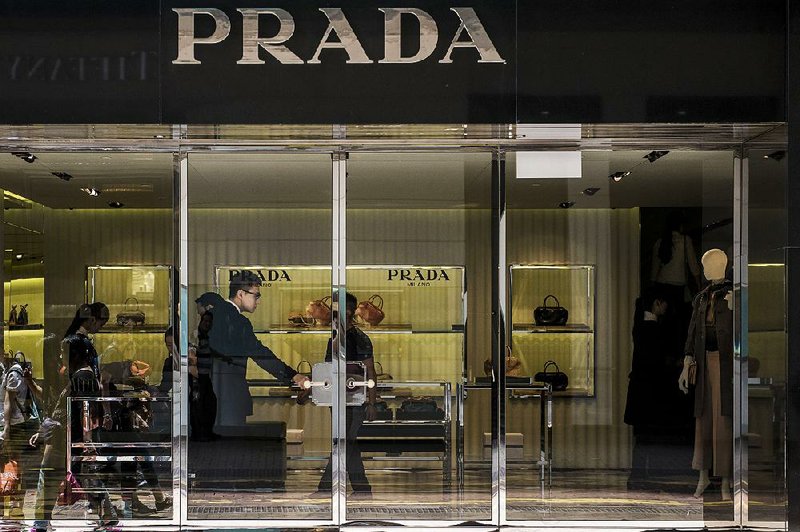HONG KONG -- One of Hong Kong's busiest shopping streets winds past the Times Square center, under slick signs for the Mont Blanc, Cartier, Gucci and Burberry brands.
But inside the towering luxury mall, the hum of the crowds below fades into the quiet of rows of mostly empty boutiques.
A sales attendant greeted a few people outside a Chanel shop. "I'm sorry, you have to queue," she said, waving her hand toward a seemingly imaginary line of shoppers. But few people entered the store on what would usually be a bustling weekend shopping day.
Boom times for luxury in China are largely over after the recent stock market rout and currency devaluation, compounded by an already slowing economy and a government crackdown on lavish gift-giving. The effect of those woes on Chinese shoppers -- who make up as much as a third of global spending on high-end goods -- has rattled both investors and global luxury brands.
The quieter scenes at Times Square and luxury stores elsewhere in Hong Kong paint a stark contrast to the fevered spending of recent years, when young, upwardly mobile Chinese seemed to have insatiable appetites for Chanel handbags and Hermes scarves.
After growing by double digits in the past decade, spending on luxury goods in China contracted for the first time last year to about $18 billion, shrinking 1 percent, according to the consultancy Bain & Co.
On top of the market turmoil, moves by the Chinese government to devalue the renminbi and concerns over further rounds of devaluation cast a new pall on the luxury marketplace.
"This is going to hit hard," said David Friedman, the president of Wealth-X, a luxury intelligence firm. Friedman, who is based in New York, added, "It's the straw that breaks the camel's back for luxury brands that looked at the Chinese consumer as a driver of their revenue growth."
"Is the Chinese consumer still incredibly important to luxury brands? The answer is absolutely yes. But is the Chinese consumer over the next several years going to be the same economic juggernaut of consumption for these brands? The answer is no."
These jitters stem from how disproportionately global luxury brands have leaned on China for growth. Greater China drives as much as 25 percent of sales at Burberry, and 20 percent of sales at Prada, according to estimates by Exane BNP Paribas. The Swatch Group, whose brands include Omega, Harry Winston and Balmain, derives as much as 35 percent of its sales in mainland China, Hong Kong and Macau.
Those percentages would be even higher if they took account of all the luxury goods that Chinese tourists snap up overseas, where items are often cheaper than in Beijing or Shanghai, where shoppers must pay import duties. According to Bain & Co., nearly half of Chinese luxury spending occurs outside China.
A weaker renminbi would make it more expensive for Chinese consumers not just to buy foreign luxury products in China but also to travel overseas to cities like New York or Milan to buy luxury goods. A shakier economy and market turmoil back home would damp travel, as well as demand.
"Things are becoming more expensive, people are traveling less, and market turmoil is causing people to retrench and think about their luxury spending," said Simeon Siegel, a senior equity analyst in specialty retailing and luxury for Nomura Securities. "So you walk down Fifth Avenue, and you see emptier stores."
Zhou Ting, director of the Fortune Character Institute, a research firm based in Shanghai that publishes the annual China Luxury Report, said she expected Chinese luxury tourism to continue despite the market uncertainties and the drop in value of the renminbi, also known as the yuan.
Chinese travelers are drawn overseas partly by a hunt for value, she explained. Because of high tariffs, a Furla luxury handbag her firm examined recently cost $310, with the steepest discounts available in China, but it sells for just a third of that price at the Leonardo da Vinci airport in Rome.
"The new yuan depreciation is not nearly enough to deter the very strong urge of Chinese shoppers to buy luxury goods overseas," she said.
At the Tai Koo Li mall in central Beijing, a gleaming expanse of luxury retailers including Lanvin, Versace and Vera Wang, several shoppers shrugged off the recent currency moves.
Xu Zijin, 19, a sophomore at a university in California, said she normally bought luxury goods in the United States because "the price is always very high in China," and she would continue to do so.
For some brands, like Coach, which manufactures a majority of its handbags in China, a weaker renminbi could even be a positive, Oliver Chen, a retail analyst at the Cowen Group, said in a recent report. Gross margins at Coach, for instance, would benefit from lower input costs -- especially lower wages for Chinese workers -- if currency rates remained at their current level, Chen said.
Andrea Shaw Resnick, head of investor relations and corporate communications at Coach, said it was still too early to project the impact of the weaker renminbi on sales trends.
Still, "we've been managing through exchange rate fluctuations for many years," Resnick said. "Importantly, our sourcing of both finished goods and raw materials in the region provides some degree of natural hedge," he said. "Of course, we'll continue to monitor the situation closely."
Information for this article was contributed by Dan Levin and Adam Wu of The New York Times.
SundayMonday Business on 08/30/2015

